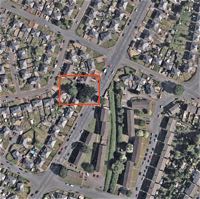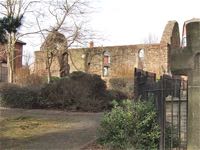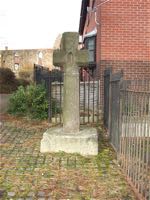
St Loyes Chapel
Page added 20th November 2015
 The Chapel of St Loye, situated in East Wonford, is now a ruin, but it was once a domestic chapel, housing, a stable and a cow shed. The historian Ethel Lega-Weekes believed the chapel dated from around 1238, as William Gervais (Mayor and founder of Exe Bridge) was an important landowner, in East Wonford, in that year, and may have erected the building.
The Chapel of St Loye, situated in East Wonford, is now a ruin, but it was once a domestic chapel, housing, a stable and a cow shed. The historian Ethel Lega-Weekes believed the chapel dated from around 1238, as William Gervais (Mayor and founder of Exe Bridge) was an important landowner, in East Wonford, in that year, and may have erected the building.
It was recorded that, in 1387, that Henry and Joan Tirrel were granted permission to celebrate mass in the chapel of St Elegius, (St Loyes) particularly on the morrow of the Feast of Holy Trinity every year, during the bishop's pleasure. In 1587 the estate of St Loyes was divided into four. Two-fourths consisted of three messuages and nine acres of land. One of the three messuages was the Chapel of St. Loye. Roger Ayshford of Aysheford in Burlescombe sold to John Leigh and Wm. Glandfeilde part of the messuage and lands called "Sancte Loyes." The chapel and the ground around it, were granted on the 19th of January 1588, by Leigh and Glanfeylde to twelve trustees for the use of the poor of Heavitree, in consideration of £38 paid to them out of the Parish Stock. The Parish Stock was a sum of money left over from previous charities, or money left in wills for the poor.
From 1587, when the original estate was divided into fourths, the fund was managed by two annually elected parochial officers, known as "Wardens of St. Loyes". As early as 1607 "halfe of the Chapell" was let as a dwelling. From 1625 there seems to have been only one warden, who was distinct from the feoffees (trustees). In 1771 his office was abolished, as shown by the accounts of the Rev. J. Simons, a trustee, who says that he had singly undertaken the office of treasurer and acting trustee— the office of Warden of St. Loyes fell from use.
By 1785 it was used as a stable, then a cow-shed. When the Rev. S. Berkeley actively promoted its partial repair, which was undertaken by Mr. Harbottle Reed. Now only the ruins remain, surrounded by hundreds of homes, a reminder of earlier times when a chapel could be built for the use of a couple of dozen citizens. There is a stone cross at the entrance to the grass area on which the ruins stand.
The chapel measures 35 ft by 18 ft 8 inches. The bulk of the structure is Early English–early in the period 1190-1275–retaining in the south side three Lancet windows, with external rebate for reception of shutters. A quatrefoil window in the east gable and a pointed two light window in the west wall are of the Decorated period. The stone was probably sourced from the nearby Heavitree quarry. It is thought that the roof was heavily slated, and that there was a cross on top of each gable.
St Elegius’ or St Loye’s
St. Eligius, or St. Loye (in French, St. Eloy), is the patron saint of goldsmiths, metalworkers, and coin collectors. To keep him even busier, he is also the patron saint of vets, and the Royal Electrical and Mechanical Engineers. He is best known as the patron saint of horses. He was born at Catelet, near Limoges, about the year 588.
Loye was of good parentage,who was apprenticed to a goldsmith, named Abbo, master of the mint at Limoges. After he qualified he went to Paris, and gained a commission from King Clotaire II., to make a state chair or throne, encrusted with gold and gems given him for the purpose. With these materials, Loye made two chairs, delighting the king, who liked his honesty. He took him into the household and made him master of the Paris mint. His name appears on gold coins struck at Paris in the reigns of Dagobert I. and his son Clovis II. He was a religious man, and he sang the canonical office twice daily in his home, assisted by his servants and family. He was admitted to the priesthood, and consecrated by the Bishop of Noyon in 640, at Rouen. He died of fever on the 1 December, 659, aged more than seventy years old. He was buried in the Church of St. Lupus, of Troyes, and his friend St. Owen, who wrote his life thirteen years afterward, tells us that the church was afterwards known as St. Eligius, and that many miracles followed his death.
Sources: Worthy's Suburbs of Exeter, Wikipedia and Exeter Churches by Edith Creswell, and an article in Transactions of the Devonshire Association by Miss Ethel Lega-Weekes Vol 52..
│ Top of Page │

